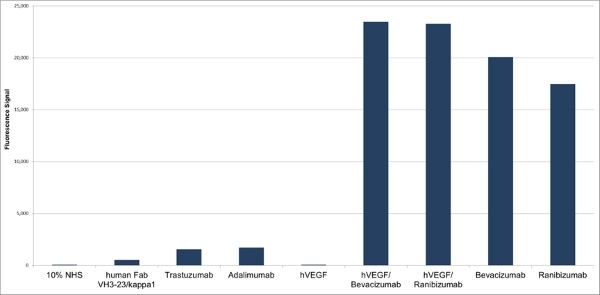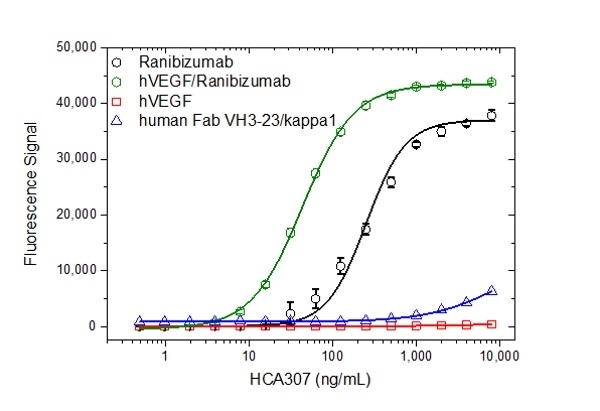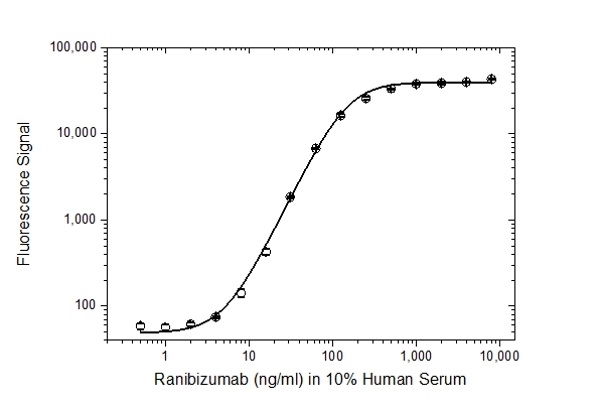Ranibizumab antibody | AbD29865



Human anti Ranibizumab
- Product Type
- Monoclonal Antibody
- Clone
- AbD29865
- Isotype
- HuCAL Fab monovalent
- Specificity
- Ranibizumab
| Human Anti-Ranibizumab Antibody, clone AbD29865 is a non-inhibitory anti-idiotypic antibody that specifically recognizes the monoclonal antibody drug ranibizumab or ranibizumab when in complex with recombinant human vascular endothelial growth factor A (VEGF-A). It can be used to measure free ranibizumab and biosimilars in patient samples. Clone AbD29865 is a monovalent Fab format antibody that can be used to develop a pharmacokinetic (PK) antigen capture assay to measure free ranibizumab captured via immobilized VEGF-A. This antibody also recognizes bevacizumab or bevacizumab in complex with human VEGF-A. Ranibizumab (Lucentis) is a humanized Fab fragment antibody (VH3-23/kappa1), originating from the same parental mouse antibody as bevacizumab (Avastin); it has 4 amino acid exchanges in the heavy chain and 1 amino acid exchange in the light chain compared to bevacizumab. Ranibizumab was first approved to treat wet age-related macular degeneration (AMD), a common form of age-related vision loss. It is also approved for the treatment of macular edema following retinal vein occlusion, diabetic macular edema, and diabetic retinopathy. Ranibizumab inhibits angiogenesis by binding to VEGF-A, blocking its interaction with VEGF receptors on the surface of endothelial cells, and thus preventing the subsequent growth of new blood vessels. View a summary of all anti-ranibizumab antibodies |
|
- Product Form
- A monovalent human recombinant Fab (lambda light chain) selected from the HuCAL phage display library, expressed in E. coli The antibody is tagged with a DYKDDDDK tag and a HIS-tag (HHHHHH) at the C-terminus of the antibody heavy chain. This antibody is supplied as a liquid.
- Preparation
- Metal chelate affinity chromatography
- Source
- E.coli
- Buffer Solution
- Phosphate buffered saline
- Preservative Stabilisers
- 0.09% Sodium Azide (NaN3)
- Immunogen
- Ranibizumab
- Affinity
- The intrinsic affinity of the monovalent form of Human anti Ranibizumab antibody, clone AbD29865 is KD= 5 nM as measured by real time, label-free molecular interaction analysis on immobilized VEGF-A/ranibizumab complex.
- Approx. Protein Concentrations
- Antibody concentration 0.5 mg/ml
- Regulatory
- For research purposes only
- Guarantee
- 12 months from date of despatch
- Acknowledgements
- This product and/or its use is covered by claims of U.S. patents, and/or pending U.S. and non-U.S. patent applications owned by or under license to Bio-Rad Laboratories, Inc. See bio-rad.com/en-us/trademarks for details.
Lucentis is a trademark of Genentech.
His-tag is a trademark of EMD Biosciences. - Licensed Use
- For in vitro research purposes and for commercial applications for the provision of in vitro testing services to support preclinical and clinical drug development. Any re-sale in any form or any other commercial application needs a written agreement with Bio-Rad.
Avoid repeated freezing and thawing as this may denature the antibody. Storage in frost-free freezers is not recommended.
| Application Name | Verified | Min Dilution | Max Dilution |
|---|---|---|---|
| ELISA |
- Technical Advice
- Recommended protocols and further information about HuCAL recombinant antibody technology can be found in the HuCAL Antibodies Technical Manual.
- ELISA
- Human anti Ranibizumab antibody, clone AbD29865 can be used in a direct or indirect ELISA on Ranibizumab or as a detection reagent for free Ranibizumab captured via immobilized VEGF-A.
Protocol: PK antigen capture ELISA to measure free drug .
| Description | Product Code | Applications | Pack Size | List Price | Your Price | Quantity | |
|---|---|---|---|---|---|---|---|
| LYNX Rapid HRP Antibody Conjugation Kit | LNK002P | CJ | 3 Conjugations For 400µg Antibody | Log in | |||
| List Price | Your Price | ||||||
| Log in | |||||||
| Description | LYNX Rapid HRP Antibody Conjugation Kit | ||||||
| Mouse anti Human IgG (Fc) CH2 Domain:HRP | MCA647P | C * E | 0.2 mg |
|
Log in | ||
| List Price | Your Price | ||||||
|
|
Log in | ||||||
| Description | Mouse anti Human IgG (Fc) CH2 Domain:HRP | ||||||
- Synonyms
- Lucentis
HCA307
If you cannot find the batch/lot you are looking for please contact our technical support team for assistance.
Please Note: All Products are "FOR RESEARCH PURPOSES ONLY"
Always be the first to know.
When we launch new products and resources to help you achieve more in the lab.
Yes, sign me up

